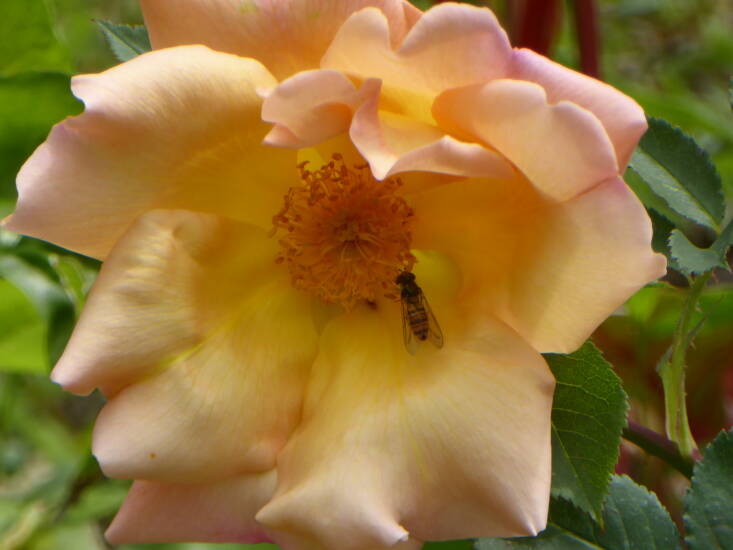There are many considerations when it comes to choosing a rose: Do you like the color? Will it repeat flower or produce wonderful hips? Does it have a delicious scent? Will it grow to suit the space or the way you want to use it? Few of us, though, give a thought to whether it will be beloved by bees and other pollinators, and yet roses can provide an excellent source of nectar.
Photography by Clare Coulson, unless otherwise noted.

Many modern roses are bred with a laser focus on form, color, scent, and health. Densely ruffled flowers and deep cups are often prized for their exquisite, romantic looks, too. But pass by these beauties, because it’s the single, open roses that work best for pollinators—if the stamens are visible and easy to access, so much the better for busy bees.

Most species roses fall into this category —these wild plants are the original roses. They are tough and come in many forms—shrubs, climbing, rambling—but tend to have single or open flowers and exceptionally good health. Rosa glauca and rugosa, as well as dog roses, are some of the best known species roses, but there are hundreds of different types.
Roses that have been bred can also display similar qualities to these ancestors, echoing their open flowers, visible stamens, and profusion of blooms. Here are a few of our favorites.
Rosa ‘Florence Mary Morse’

Rosa ‘Fighting Temeraire’

Rosa ‘Blush Noisette’

Rosa ‘The Lark Ascending’

Rosa ‘Rambling Rector’

Rosa ‘Frances E. Lester’

Rosa ‘Sceptre’d Isle’

Rosa ‘Madame Gregoire Staechelin’

See also:
- Roses in the Kitchen: How to Bottle Their Sweet Fragrance for Syrups and Drinks
- 8 Favorites: Native Roses
- Dreaming of Roses? Now’s the Time to Plant Them Bare Root
Frequently asked questions
What are pollinator-friendly roses?
Pollinator-friendly roses are a variety of roses that attract and provide a food source for bees, butterflies, and other beneficial insects. These roses usually have single, open blooms with abundant nectar and pollen.
Why are pollinators important in a garden?
Pollinators, such as bees and butterflies, play a crucial role in the reproduction of plants by transferring pollen from the male to the female parts of flowers. They help fertilize flowers, which leads to the production of fruits, seeds, and new plants. Without pollinators, many plants, including roses, would not be able to reproduce successfully.
How do pollinator-friendly roses benefit the garden?
Pollinator-friendly roses not only support the health and growth of roses but also contribute to the overall biodiversity and health of the garden. By attracting pollinators, these roses help in the pollination of other plants in the garden, leading to increased fruit production and a thriving ecosystem.
What are some popular pollinator-friendly rose varieties?
Some popular pollinator-friendly rose varieties include 'The Fairy', 'Carefree Delight', 'Knock Out', 'Bonica', and 'Blanc Double de Coubert'. These roses have single or semi-double blooms, high fragrance, and provide abundant pollen and nectar for pollinators.
How to attract pollinators to a rose garden?
To attract pollinators to a rose garden, plant a variety of pollinator-friendly flowers alongside the roses. Choose plants that bloom at different times throughout the seasons, providing a continuous source of nectar and pollen. Avoid using pesticides and provide a water source for pollinators.
Can pollinator-friendly roses be grown in containers?
Yes, pollinator-friendly roses can be grown in containers, provided that the containers are large enough to accommodate the root systems of the roses. Use well-draining potting soil and ensure the container receives adequate sunlight and water.
Are pollinator-friendly roses low maintenance?
Most pollinator-friendly roses are known for their disease resistance and adaptability, making them relatively low maintenance. However, regular watering, proper pruning, and occasional fertilization may still be required to ensure healthy growth and blooming.
Can pollinator-friendly roses be used in floral arrangements?
Yes, pollinator-friendly roses can be used in floral arrangements. Their open blooms and fragrant petals make them a popular choice for both garden display and cut flowers. However, it is essential to leave some blooms for pollinators in the garden.
Are pollinator-friendly roses suitable for all climates?
There are pollinator-friendly rose varieties available for various climates. It is recommended to choose roses that are specifically bred or recommended for your climate zone to ensure successful growth and blooming.
Where can I buy pollinator-friendly roses?
Pollinator-friendly roses can be purchased from local nurseries, garden centers, or online gardening stores. Check with your local gardening community or search for reputable online sources to find a wide selection of pollinator-friendly rose varieties.









Have a Question or Comment About This Post?
Join the conversation